Confused about white versus yellow glue? Or what glue is best for marine applications? Or for repairing antique furniture? Or for securing a loose fitting joint? Or for stabilizing a crack? Or for temporarily holding a part in place? Well, here’s a short primer on woodworking glues that should help shed some light on these types of questions.
White Glue
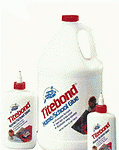
White glue
White glue is a decent all-purpose adhesive for paper and wood. It is similar to yellow glue in terms of bonding strength although it is a bit more flexible but not quite as moisture resistant. The biggest difference is that white glue takes longer to set up or cure than yellow glue. This increased “open time” can be advantageous if you’re gluing up a complex piece of furniture. Of course, it also means longer clamping time.
In chemical-speak, white and yellow glues are known as polyvinyl acetate adhesives, or PVA for short. PVA’s made their debut in the 1950’s with white Elmer’s glue and over time, they have become extremely popular, especially for woodworking applications. This is because PVA’s are easy to use, inexpensive (relative to other glues), non-toxic, and have a long shelf life. They’re also water soluble, which makes them easy to clean off with just plain water. This water solubility is also a drawback because a PVA glue joint will weaken when exposed to high moisture levels.
Yellow Glue
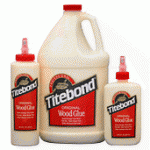
Yellow glue
The glue of choice for many woodworkers is yellow glue, also called carpenter’s glue.
Common brands include Elmer’s and Titebond. Compared to white glue, yellow glue is more moisture resistant (especially the “water resistant” varieties) and it cures faster. This faster curing can make assembly tricky at times but it also results in shorter clamping times. You can figure on about 5 to 10 minutes of open time and one-half to one hour of clamping time. Yellow glue also tends to be thicker than white glue and does have some small gap-filling capabilities – but not nearly to the degree offered by epoxy.
Conventional white or yellow glues do not take stains very well so it is important to clean off any excess glue that squeezes out of a joint. There are PVA glues with dye in them (marketed as “dark” wood glue) that will dry to a darker color than conventional white or yellow glue. These glues are appropriate for darker colored woods such as walnut or cherry. Elmer’s also sells a “stainable” wood glue that contains actual wood fibers to better accept stains. I have not personally tried this product but have read reviews that indicate it does indeed accept stains better than standard yellow glue but don’t count on it to provide an exact match to the surrounding wood.
Water Resistant Yellow Glue (cross-linked PVA)
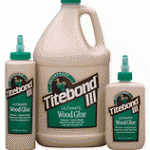
Titebond III
Yellow glues with enhanced water resistance have appeared on the market in recent years. Some specific products include Titebond II Premium Wood Glue, Titebond III Ultimate Wood Glue, Elmer’s Waterproof Wood Glue, and Elmer’s Carpenter’s Exterior Wood Glue. These adhesives are appropriate for exterior trim, doors, or deck furniture but not for marine use or applications where the wood is immersed in water. Compared to conventional yellow glues, the water resistant varieties are pricier so it doesn’t make sense to use them for interior applications where water resistance is not important.
Polyurethane Glue
Polyurethane glue is a relative newcomer in the glue world but it has been coming on strong. Polyurethane glue is water-proof, making it good choice for outdoor projects. It forms a strong bond on both porous and non-porous surfaces and even works well with oily woods. Another positive attribute is that it has a much longer open time than PVA’s (about 30 minutes), making for a more relaxed assembly process.
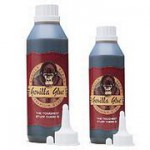
Polyurethane glue
There seems to be confusion out there about the gap filling properties of polyurethane glue. I’ve come across articles stating that polyurethane glue is capable of filling small gaps and it does in fact expand during the drying process. However, if one peruses the various manufacturers’ web sites, there is little or no mention of gap filling properties. Also, tests such as those conducted by Fine Woodworking in July/August 2007 indicate that polyurethane glue performs poorly strength wise – relative to most other glues – when used in a loose fitting joint. Bottom line: don’t rely on polyurethane glue – or any glue, for that matter – to compensate for an ill-fitting joint.
The peculiar thing about polyurethane glue is that it is activated by water so it is ok to dampen the wood surfaces during glue-up to hasten the curing process. In fact, this is recommended, especially if working in low humidity conditions or wood that is very dry. Once the glue cures, it will be impervious to water so the joint can actually be immersed in water and it won’t fall apart. How cool is that?
In many respects, polyurethane glue is a wonder glue but there are some gotchas. One of these is price: you can expect to pay considerably more for poly glue than for conventional yellow glue — perhaps 3-4X as much. Another is a short shelf life – about 1 year for an unopened container, 6 months for an opened one. In contrast, it’s not uncommon to get 2-3 years out of PVA’s even after opening the bottle. I once spent about $8 on a bottle of poly glue and only used a small amount to glue up some woodworking mallets. When I retrieved the glue a few months later for another project, it had turned into a solid mass. I wasn’t too happy about that. So, unless you plan to do a lot of gluing over a short time period, it’s better to go with a small container of poly glue. It comes in sizes as small as 4 ounces. It also helps to squeeze excess air out of the container before storing it.
Hide Glue
Hide glue is made from collagen, a protein found in animal hides, hooves, bones, tendons, and other connective tissue. (maybe that’s what became of old Clyde the packhorse…) It is an old glue, dating back at least to the ancient Egyptians some 5000 years ago, and has historically been the most popular woodworking glue. However, in recent years, it has fallen out of mainstream use with the introduction of modern glues that are easier to apply and have a longer shelf life (and perhaps don’t smell as nasty).
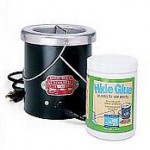
Hide glue
The defining trait of hide glue is that it is reversible. This means that if a hide glue joint fails, it can be easily repaired by dissolving the old glue with warm water and then adding new glue. You can even add new glue without removing all of the old glue. (In contrast, PVA glue does not adhere to other PVA glues once they are cured). For these reasons, hide glue is the glue of choice for antique furniture restoration since most old furniture was constructed with hide glue. Hide glue has also been favored for musical instrument makers because of its ease of repair and the fact that it tends to form a clean break in the glue itself – rather than the wood – when a joint fails or is deliberately broken to perform a repair.
Hide glue is sold in the form of sheets, flakes, or pellets that are then mixed with water and heated in a glue pot. There is also a pre-mixed liquid variety but it has a more limited shelf life than the dry variety. Hide glue forms a strong bond that can be sanded and stained. It actually accepts stains better than most glues. And errant glue spots don’t show up as much after staining the wood as they would with yellow glue. Clean up is also a cinch – just scrape off the excess and use warm water to clean up the tools and any leftover spots on the wood.
Contact Cement
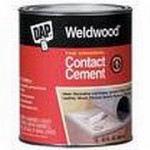
Contact cement
Contact cement is a niche adhesive that is unrivaled for attaching flexible veneers and plastic laminates such as Formica.
The way you use contact cement is a bit unusual: It is applied to both surfaces to be joined and then allowed to dry – usually 15-30 minutes will suffice. Then the pieces are lined up – but kept apart via wooden dowels or rods. Once the alignment is perfect – there’s no room for slop – the dowels are removed one at a time and the two pieces bond together immediately upon contact (hence the name). There’s no need for clamping and there’s nothing you can do if the pieces are misaligned because the resulting bond is very strong. The pieces are co-joined buddies for life…
The biggest advantage of contact cement is that it does not require clamping, which is a big deal when working with large surface areas such as countertops. On the negative side, solvent based contact cement is flammable and smelly, although newer water-based formulations are much improved in both respects.
Epoxy
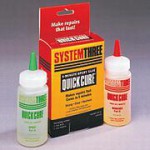
Epoxy
If you’ve ever built or repaired a boat, you’re probably familiar with epoxy. This adhesive forms a waterproof bond that holds up extremely well under wet conditions — like what a boat experiences. It also scores well in terms of gap filling, bonding of end grain and oily woods, shrinkage, heat and chemical resistance, sanding, and staining. It’s strength properties are impressive too: tests by Fine Woodworking showed that epoxy was the second strongest glue (water resistant PVA glue came in first).
With all these wonderful attributes, why isn’t epoxy more commonly used for woodworking? Well, for one thing, epoxy is fairly expensive — at least 2-3 times more so than yellow glue. It also requires a bit of effort to prepare. Epoxy comes in two parts, a resin and a hardener, that must be mixed together to initiate the curing process. Once mixed, the open time varies from a few minutes to hours depending on the formulation. Any left-over mixture will have to be discarded so it’s important to gauge exactly how much adhesive is needed.
After epoxy has hardened, it’s difficult to remove cleanly so keep an eye open for squeeze-out. It also emits plenty of fumes so work in an area with good ventilation.
Hot Melt Glue
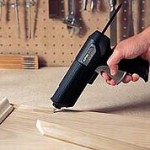
Hot melt glue
When you need to bond materials quickly and temporarily, hot melt glue is the ticket. It comes as cylindrical sticks of thermoplastic that fit into an electrically heated glue gun. When the trigger is squeezed, out comes warm, sticky glue that hardens and cools within a half-minute or less. Because it sets so quickly, hot melt glue is ideal for temporary attachment of jigs and templates, for holding small parts for routing, and for securing pieces in place while more permanent adhesives set up. It’s almost like having a third hand!
Instant Glue (Cyanoacrylate)
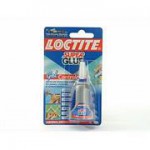
Super glue
Although not as commonly used as some of the other woodworking glues described here, instant glue or cyanoacrylate does have its place in the wood shop. Sold under trade names like Super Glue and Krazy Glue, cyanoacrylate adhesives are ideal for fixing small parts, building wooden models, repairing small chips, and filling cracks. Wood turners are especially enamored of instant glue because of its utility for repairing cracked turning blanks and for stabilizing spalted turning woods.
Instant glues have short set times – ranging from a few seconds to almost a minute – and do not typically require clamping. The cured adhesive has good water resistance but is not waterproof. It also tends to be brittle so instant glues are not recommended for conventional furniture joinery.


